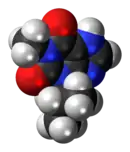| |||
| Names | |||
|---|---|---|---|
| IUPAC name
1-Methyl-3-(2-methylpropyl)-7H-purine-2,6-dione | |||
| Other names
3-Isobutyl-1-methylxanthine | |||
| Identifiers | |||
3D model (JSmol) |
|||
| ChEBI | |||
| ChEMBL | |||
| ChemSpider | |||
| DrugBank | |||
| ECHA InfoCard | 100.044.767 | ||
| KEGG | |||
PubChem CID |
|||
| UNII | |||
CompTox Dashboard (EPA) |
|||
| |||
| |||
| Properties | |||
| C10H14N4O2 | |||
| Molar mass | 222.3 g/mol | ||
| Appearance | White solid | ||
| Melting point | 199 to 201 °C (390 to 394 °F; 472 to 474 K) | ||
| Solubility | Soluble in ethanol, DMSO, and methanol | ||
Except where otherwise noted, data are given for materials in their standard state (at 25 °C [77 °F], 100 kPa).
Infobox references | |||
IBMX (3-isobutyl-1-methylxanthine), like other methylated xanthine derivatives, is both a:
- competitive non-selective phosphodiesterase inhibitor[1] which raises intracellular cAMP, activates PKA, inhibits TNFα[2][3] and leukotriene[4] synthesis, and reduces inflammation and innate immunity,[4] and
- nonselective adenosine receptor antagonist.[5]
As a phosphodiesterase inhibitor, IBMX has IC50 = 2–50 μM[6] and does not inhibit PDE8 or PDE9.[7]
References
- ↑ Essayan, DM (November 2001). "Cyclic Nucleotide Phosphodiesterases". The Journal of Allergy and Clinical Immunology. 108 (5): 671–80. doi:10.1067/mai.2001.119555. PMID 11692087.
- ↑ Deree, J; Martins, JO; Melbostad, H; Loomis, WH; Coimbra, R (June 2008). "Insights into the Regulation of TNF-α Production in Human Mononuclear Cells: The Effects of Non-Specific Phosphodiesterase Inhibition". Clinics (Sao Paulo). 63 (3): 321–8. doi:10.1590/S1807-59322008000300006. PMC 2664230. PMID 18568240.
- ↑ Marques, LJ; Zheng, L; Poulakis, N; Guzman, J; Costabel, U (February 1999). "Pentoxifylline Inhibits TNF-α Production from Human Alveolar Macrophages". American Journal of Respiratory and Critical Care Medicine. 159 (2): 508–11. doi:10.1164/ajrccm.159.2.9804085. PMID 9927365.
- 1 2 Peters-Golden, M; Canetti, C; Mancuso, P; Coffey, MJ (15 January 2005). "Leukotrienes: Underappreciated Mediators of Innate Immune Responses" (PDF). Journal of Immunology. 174 (2): 589–94. doi:10.4049/jimmunol.174.2.589. PMID 15634873.
- ↑ Daly, JW; Jacobson, KA; Ukena, D (1987). "Adenosine Receptors: Development of Selective Agonists and Antagonists". Progress in Clinical and Biological Research. 230: 41–63. PMID 3588607.
- ↑ Beavo, JA; Rogers, NL; Crofford, OB; Hardman, JG; Sutherland, EW; Newman, EV (November 1970). "Effects of Xanthine Derivatives on Lipolysis and on Adenosine 3',5'-Monophosphate Phosphodiesterase Activity". Molecular Pharmacology. 6 (6): 597–603. PMID 4322367.
- ↑ Soderling, SH; Beavo, JA (April 2000). "Regulation of cAMP and cGMP Signaling: New Phosphodiesterases and New Functions". Current Opinion in Cell Biology. 12 (2): 174–9. doi:10.1016/s0955-0674(99)00073-3. PMID 10712916.
This article is issued from Wikipedia. The text is licensed under Creative Commons - Attribution - Sharealike. Additional terms may apply for the media files.

